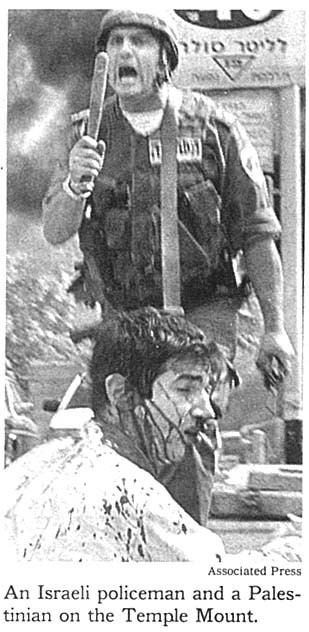 08.10.00
Eine falsche Bildunterschrift in der "New York Times" (Ausgabe 30. September)
ging durch die israelischen Medien. Unter dem Foto, das einen am Kopf schwer
blutenden jungen Menschen und einen israelischen Soldaten mit erhobenem
Schlagstock zeigt, steht: „Ein israelischer Polizist und ein Palaestinenser
auf dem Tempelberg“. In einem Leserbrief an die renommierte Zeitung hatte
ein Vater die Identität des sog. "Palästinensers" klargestellt:
08.10.00
Eine falsche Bildunterschrift in der "New York Times" (Ausgabe 30. September)
ging durch die israelischen Medien. Unter dem Foto, das einen am Kopf schwer
blutenden jungen Menschen und einen israelischen Soldaten mit erhobenem
Schlagstock zeigt, steht: „Ein israelischer Polizist und ein Palaestinenser
auf dem Tempelberg“. In einem Leserbrief an die renommierte Zeitung hatte
ein Vater die Identität des sog. "Palästinensers" klargestellt:
Hier nochmals ausführlich der Bericht von Tuvia Grossmann (auf englisch):
I was thrust into the international limelight when The New York Times and
other major media outlets published a photo of me -- bloodied and battered
-- crouching beneath a club-wielding Israeli policeman. The caption
identified me as a Palestinian victim of the new intifada. In fact, however, I
am a 20-year-old Jewish student from Chicago, studying at a yeshiva in
Jerusalem.
Here's how it all happened:
It was the eve of Rosh Hashana, and I hailed a taxi with two of my friends
to go visit the Western Wall. Along the way, the driver took a shortcut
through one of the Arab neighborhoods in Jerusalem. We turned a corner
and suddenly there were about 40 Palestinians surrounding the car. Before
we knew it, huge rocks had smashed all the windows of the taxi.
Some of the Palestinians pulled open the door and dragged me from the
vehicle. About 10 attackers jumped on top of me, punching and kicking
me. I crouched to the ground, and tried to cover my face to protect myself
as much as possible. All I could see were a flurry of sneakers kicking me
in the face.
Then I felt a strong pair of hands grabbing me, and I uncovered my face
because I thought someone was trying to help me. But it was just another
Palestinian; he held the back of my head and punched me square in the
face. I fell flat on the ground and the Palestinians jumped on top of me
again. One of them stabbed me in the back of my leg, ripping through
muscles and tendons. Two other Palestinians held my head so I couldn't
move, while two more bashed rocks onto my head... again and again and
again.
By this time the beating had gone on for about eight minutes. I had already
lost three liters of blood and was losing consciousness. I said "Shema
Yisrael" -- the declaration of faith that a Jew says before he dies. I tried not
to black out, because I was sure if I did it would be the end.
Because it was the eve of Rosh Hashana, the image of a shofar flashed
through my mind, and I recalled a Biblical story I'd learned in school. The
prophet Gideon and his 300 men were badly outnumbered against the
Midianite army of 130,000. So Gideon's troops banged pots and blew
shofars, hoping that the noise would scare the enemy. With God's help,
the ploy worked, and Gideon won the battle.
So I yelled at the top of my lungs. The Palestinians were startled
momentarily, and I was able to get up and run. Unfortunately, I am heavily
nearsighted and my contact lenses had fallen out. So there I was -- barely
able to see a thing, with blood pouring down my face and my leg badly
wounded -- being chased up a hill by 40 Palestinians throwing rocks at
me.
It was a miracle, but I somehow outran them and reached a gas station
where Israeli soldiers were posted.
I collapsed on the ground, and that's when a group of freelancer
photographers started snapping pictures. An Israeli policeman was
protecting me, yelling at the Palestinians to back off from finishing the
lynching. But the photo -- sent throughout the world by the Associated
Press -- identified me as a Palestinian. The obvious implication was that
the Israeli policeman had just beaten me. In truth, it was the total
opposite. I was a Jewish victim of Palestinian attackers.
It's bad enough to be beaten bloody, get stitches up and down my head,
and have my leg so severely stabbed that therapy is required to regain use
of it. But to be used as a pawn in the media war, as part of the Palestinian
propaganda to gain international sympathy, well, that hurts even more.
When a photo gets published, there are many links in the chain, and in
this case, I don't know where the fault for the garbled caption lies. But it is
deeply disturbing that the New York Times, the Associated Press (and
everyone else in-between) assumed that if it's a victim, it must be a
Palestinian.
There is a great struggle here in Israel and this event highlights the power
of the media to influence public opinion. If truth is to prevail, we can't just
"read" the newspaper. Be discerning and become part of the process.
Otherwise, you're just a passive object of someone else's agenda.
Who are the innocent victims and who are the aggressors? I'm living proof
-- the truth is often the opposite of how it appears.